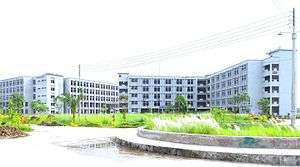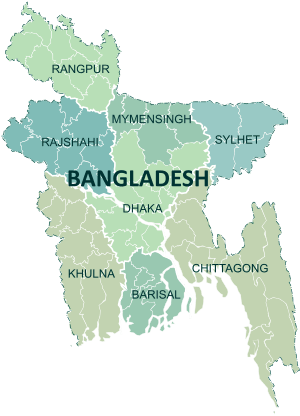Gopalganj District, Bangladesh
| Gopalganj | |
|---|---|
| District | |
 Location of Gopalganj in Bangladesh | |
| Coordinates: BD 23°12′N 89°48′E / 23.20°N 89.80°ECoordinates: BD 23°12′N 89°48′E / 23.20°N 89.80°E | |
| Country |
|
| Division | Dhaka Division |
| Area | |
| • Total | 1,468.74 km2 (567.08 sq mi) |
| Population (2011 census) | |
| • Total | 1,172,415 |
| • Density | 800/km2 (2,100/sq mi) |
| Time zone | BST (UTC+6) |
| Postal code | 8100 |
Gopalganj (Bengali: গোপালগঞ্জ জেলা) is a district (zilla in Bengali) in the Dhaka division of Bangladesh.[1] The district has about 1,172,415 civilians and its surface area is 1,490 km². The main city of the district is also called Gopalganj. It stands on the bank of the Modhumoti river and located at 23000’47.67” N 89049’2141”E. It is bounded by Faridpur district on the North, Pirojpur and Bagerhat district on the South, Madaripur & Barisal district on the East and Narail district on the West.
Gopalganj is subdivided into five sub-districts (upazila/thana).
The Office of the Deputy Commissioner, Gopalganj has developed a web portal of the district as www.gopalganj.gov.bd under the 'Access to Information' program of the Prime Minister's Office. This has been done under the Digital Bangladesh implementation concept of the incumbent government.
History
This area was under the southern part of ancient Bengal called Vanga. Around 300 BC here in Kotalipara was the capital of Gangaridai dynasty. Gangaridai was one of the powerful kingdom of Indian subcontinent. It was described by the Greek traveller Megasthenes in his work Indica. During Sultanate and Mughal period several Hindu kings ruled the area. In 1713, Muksudpur Upazila was part of Jessore district while the rest of Gopalganj was part of Dhaka - Jalalpur District. Muksedpur was later transferred to Faridpur district in 1807. Gopalganj Gopalganj Sadar and Kotalipara was part of Jalalpur Porgona of Faridpur district. Chandana (now Modhumoti) river was the borderline for Jessore and Dhaka - Jalalpur districts in 1812. Gopalgnaj - Madaripur was a large water body back then where maritime robbery was a regular activity. Thus, Madaripur Mohakuma or Sub-division was separated in 1854 from Bakergonj District.
Later, Gopalganj emerged as a Police Station in 1872 under the Madaripur Mohakuma or Sub-division vide Calcutta Gazette of 1870. In 1873, Madaripur Mohakuma or Sub-division was transferred to Faridpur district from Bakergonj district. Later in 1909, it was separated from the Madaripur Mohakuma of Bakergonj district to form a new Gopalganj Mohhakuma or sub-division. Later, Muksudpur Police Station of Faridpur district joined Gopalganj and Kotalipara police stations of Gopalganj Mohakuma or sub-division of Faridpur district.
The first SDO (sub-divisional officer) was Mr. Suresh Chandra Sen. In 1910, the sub-divisional officer's bench court was transformed into Criminal Court. In 1921, Gopalganj was elevated to township status which was inhabited by only 3,478 persons. 1925 saw the initiation of Civil Court. In 1936, Muksudpur was split to form Kashiani police station.
Gopalganj Mohakuma or sub-division emerged as Gopalganj district on the 1st day of February in 1984. Mr. AFM Ehiya Chowdhury was the first District Commissioner of Gopalganj District.
In the same year, Tungipara was separated from the Sadar Upazila to form a new upazilla namely Tungipara upazilla. After the liberation war in 1972, Gopalganj Sadar became Municipality or Pourashava and Panna Biswas was selected as its first Chairman.
Liberation War
Bangabondhu Sheikh Mujibur Rahman who hailed from the district declared independence of Bangladesh. Hemaet Uddin, leader of Hemaet Bahini, is known for his gallantry contribution in the Liberation War of 1971. The very first protest of the Liberation War occurred at the . 5 members of the Police who participated in the first protest of the Liberation War at Razarbag Police Line are the sons of this district. Martyrs of the war included Professor Santosh Das, Abdul Latif, Golzar Hossen Chowdhury, Mahbubur Rahman and many others. Guerilla Training Camps took place in Bangabandhu Govt. School field, Hijlabari school field. Guerilla training and battles took place after Steamer of Major Ghouri entered Gopalganj from Khulna on 30 April. Gopalganj was not part of any sector as it was far from border areas. As a result, three forces took command of the operations namely Hemayet Bahini (Force), Mujib Bahini (Force) and Mukti Bahini (Liberation Force) under the command of Captain Hemayet Uddin Bir Bikram, Ismat Kadir and Lutfor Rahman respectively. Apart from these many members of the Army, EPR and other forces like Captain Halim, Captain Milu, Captain Shihabuddin, Captain Jamal and Abdur Rahman led other forces in their villages.
Battles
- Bhatiapara: More than a hundred Freedom fighters under the joint leadership of Captain Ismat Kabir and Captain Hemayet attacked Pakistani Army Camp at Bhatiapara Wireless Station in Kashiani Upazila around mid August 1971 killing 19 Pakistani soldiers and 5 local collaborators.
- Fukra: Freedom fighters ambushed Pakistani army at Fukra in Gopalganj Sadar around the end of October resulting in the martyrdom of 3 freedom fighters and 40 villagers.
- Rajapur: On October 14, 1971 freedom fighters under the command of Captain Hemayetuddin Bir Bikram led a battle against Pakistani forces in Rajapur of Kotalipara resulting in the death of 2 Pakistani soldiers and a freedom fighter named Ibrahim and the injury of Commander Captain Hemayetuddin.
- Surrender at Bhatiapara: After the surrender pact was signed on the 16th day of December, 1971 coalitions forces under the joint command of Colonel Jowan of Mitro Bahini (Allied Forces) and Sector Commander Major Monjur of Sector - 8 led an ambush in Bhatiapara Wireless Station Pakistani Army Camp. On 19 December, they were abled to capture the camp and 49 Pakistani forces with it.
- Others: A number of guerilla battles took place in this district. This includes battles carried out at Kotalipara by Sikir Boktar, Kekaniya, Paikkandi, Ghoradai, etc. In mid-October, Pakistani forces led killing of numerous innocent villagers of Kolabari village and burnt their homesteads in a revengeful act while on a mission to recover arms looted by Hemayet Bahini.
Politics

Gopalganj is associated with significant importance in Bangladesh politics. The district is the political bastion of the Awami League. Bangabandhu Sheikh Mujibur Rahman, the Father of the Nation and the first President of Bangladesh, hailed from the village of Tungipara in the district and began his political career in the said district. Her Excellency Sheikh Hasina Wajed, the current Prime Minister of Bangladesh also hails from the same district. Sheikh Fazlul Haq Mani, his nephew, had also been elected to Parliament from Gopalganj-2 constituency. Unfortunately both Rahman and his nephew were assassinated on 15 August 1975.
Rahman's daughter, has been elected 4 times as the Member of the Parliament (MP) from Gopalganj-3 (Kotalipara and Tungipara) constituency and thrice as the Prime Minister of Bangladesh. Her cousin and Sheikh Mani's brother, Sheikh Fazlul Karim Selim has been elected 4 times as the MP from Gopalganj-2 constituency.
Molla Jalal, Choudhury Emdadul Hoq, Khan Saheb, Sheikh Mosharrof Hossain and Advocate Khandaker Mahbub Uddin were among other popular political leaders of this area.
Transportation
Gopalganj has a great transportation system. It is a 5 hours drive away from the capital Dhaka by road subject to traffic conditions. The journey time is set to reduce once the Padma Multipurpose Bridge is opened for all. Dhaka-Khulna Highway goes through Gopalganj to connect the neighbouring districts namely Barisal, Narail, Faridpur, Madaripur, Bagerhat and Khulna. Buses leaves Dhaka for Gopalganj from both Gabtoli and Syedabad. Tungipara Express, Modhumoti, Dola, Bonoful leaves from Sayedabad for Gopalganj via Munshiganj - Mawa - Kawrakandi - Madaripur and Comfort Line, Sheba Green, Polash leaves from Gabtoli for Gopalganj via Manikgonj - Paturia - Doulotdia - Rajbari - Faridpur.[2]
Water transportation was the main medium of transport for the people of this district in the 1980s but the popularity of it has declined over time with the introduction of road connectivity. Now a launch operates between Sadarghat of Dhaka and Poisharhat of Kotalipara. However, mechanical trawlers and boats still ply through the rivers, canals and vast water bodies.
An inoperable rail line is in place till Kashiani. The train service is also set to be reintroduced after the Padma Bridge is built.
On 14 April 1986, at least 92 people were killed in Gopalganj by the heaviest hailstones ever recorded, which were the size of grapefruits and weighed around 1 kg (2.2 lb) each.[3]
Administration
Gopalganj district consists of 5 Upazillas (previously known as 'Thana or Police Station' which is essentially a sub-district) namely Gopalganj Sadar, Kotalipara, Kashiani, Muksudpur, and Tungipara; 4 Pourashavas/ Municipalities namely Gopalganj (Class A), Tungipara (Class B), Kotalipara (Class B) & Muksudpur (Class C) and 68 unions.
The main township is known as Gopalganj Sadar, which consists of 9 wards and 49 mahallas. Gopalganj municipality was constituted in 1972. It has an area of 8.59 km² and a population of 40,987; male 53.27%, female 46.73% with a population density of 4,771 per km².
Administrator of Zila Porishod:Choudhury Emdadul Haq[4]
Deputy Commissioner (DC): Md Kahlilur Rahman[5]
Subdivisions
Education
The district has 21 colleges, 181 high schools and 760 primary schools. Other notable educational institutions are as follows:
- Bangabandhu Sheikh Mujibur Rahman Science and Technology University
- Govt. Bangabandhu University College
- Gaohardanga Madrasa (historical Madrasa in southern part of Bangladesh)
- Sheikh Fazilatunnesa Govt. Mohila College
- Hazi Laal Mia City College
- S.M. Model Govt. High School
- Sheikh Russel Destitute Children Training and Rehabilitation Center at Tungipara
- Bangabandhu Poverty Reduction Training Complex
Religion
The district of Gopalganj has 356 mosques, 359 temples, 250 churches and 4 tombs.
Places of interest
- Ulpur has a former Zamindar palace which is currently used a Tafsil Office. There are also many other Zamindar mansions from Mughal and British era. Arpara has a zamindar palace of former zaminder Munshi Abdur Razzak Chowdhury. Orakandi Thakur Bari in Kashiani, Anyanya Chandra Ghat in Sadar and zaminder Girish Chandra Sen's palace in Bhatiapara of Kashiani are some other historically notable places.
Father of the Nation Bangabandhu Sheikh Mujibur Rahman's Mausoleum Complex, Boddhyo Bhumi Memorial, Court Mosque, Gaohor Danga Madrasa, Madhumati riverbank developed in 2014, Bornir Baor, Sheikh Kamal International Stadium complex (including a state of the art swimming pool and gymnasium) and Tangrakhola Bazar are some other places of attraction.
Water bodies
- Rivers: Garai, Modhumoti, Kaliganga, Madaripur Beel route channel, Hunda, Ghagore and Old Kumar rivers.
- Large Water Bodies/Beel/Haor/Baor: Borni Baor, Chandar beel and Baghyar beel.
References
| Wikimedia Commons has media related to Gopalganj District, Bangladesh. |
- ↑ Adhikari, Rabindranath (2012). "Gopalganj District". In Islam, Sirajul; Jamal, Ahmed A. Banglapedia: National Encyclopedia of Bangladesh (Second ed.). Asiatic Society of Bangladesh.
- ↑ http://www.gopalganj.gov.bd/node/434987-%E0%A6%AF%E0%A7%8B%E0%A6%97%E0%A6%BE%E0%A6%AF%E0%A7%8B%E0%A6%97-%E0%A6%AC%E0%A7%8D%E0%A6%AF%E0%A6%AC%E0%A6%B8%E0%A7%8D%E0%A6%A5%E0%A6%BE
- ↑ "World Weather/Climate Extremes Archive". Arizona State University.
- ↑ "AL men appointed administrators". The Daily Star. 16 December 2011.
- ↑ "List of Deputy Commissioners". Ministry of Public Administration.
